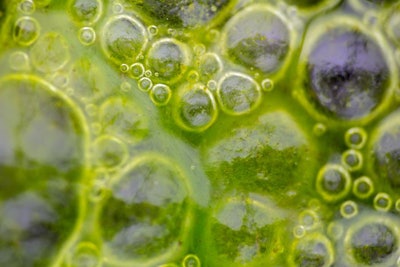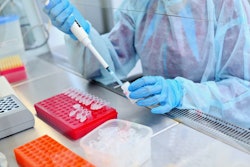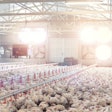
Why the future of protein production could be green and slimy
Algae may be the king of renewable super-plants with myriad potential applications ranging from biofuels, pharmaceuticals and biofertilizer to animal feed and human food.
Algae grow faster than conventional crops and require fewer resources — only a little sun, water and CO2, making it one of the most sustainable raw materials on earth. In fact, 1 kg of algae biomass can store almost 2 kg of CO2while releasing 1.6 kgs of oxygen.
Algae’s sustainable qualities help it stand out as a frontrunner in the alternative protein game. As more restaurants, grocery retailers and food brands implement sustainability initiatives across the supply chain, algae-derived ingredients are poised to gain popularity.
“It doesn’t require arable land, which is a huge advantage over crops,” said Michael McGoldrick, market manager Industrial BioTech/Starch, GEA. “Some species also do well in brackish or salt water, which means you aren’t fighting over the same resources as the other crops.”
However, production costs are a big challenge for today’s algae producers. That’s why investment in processing technologies are ramping up while efforts are underway to expand the algae market in the future.
Filling the protein gap — with plants
By the middle of this century, we’ll need more than an additional 250 million tons of protein to feed the world’s projected population. To bridge the protein gap, researchers and processing equipment suppliers are eyeing single-cell organisms — the kind of algae that contain up to 70% protein — for solutions.
GEA is one of several partners from the EU’s scientific and business community to form the Sustainable Algae Biorefinery for Agriculture and Aquaculture (SABANA) project in 2016 to focus on refining algae to support sustainable food production.
McGoldrick identified several factors driving interest and investment in the development of plant-based alternative proteins.
“The market is looking for a functional, complete protein as customers have shown a high interest in plant-based alternatives due to environmental and health beliefs,” McGoldrick said. “There are very few complete plant proteins with the full amino acid profile that humans need, so the easiest way to get around that is to blend various plant proteins, including microalgae.”
Microalgae, or phytoplankton, can provide valuable proteins, pigments and unsaturated fatty acids, along with loads of untapped opportunity. Bühler Group is another company actively engaging with the industry and academia on novel technologies to unlock the full potential of single-celled microorganisms for food and feed production.
Bühler Group’s experts estimate 200,000 to 500,000 microalgae species exist in nature, yet only about 20 species are being commercially explored today. Commercial production of more algae species could help replace a significant amount conventional crop-based animal feed protein demand in the coming decades.
 Microalgae can be cultivated in photo-bioreactors (PBRs) or open ponds and fed on wastewater — including sewage. (Hilda Weges | BigStock.com)
Microalgae can be cultivated in photo-bioreactors (PBRs) or open ponds and fed on wastewater — including sewage. (Hilda Weges | BigStock.com)Microalgae market expansion hurdles
One of the biggest challenges microalgae production faces is cost-related – partly because the algal biomass must be processed to separate it from the water it was grown in. And accessing the nutritional benefits of some microalgae relies on opening the cell wall to allow for optimal digestibility.
Getting to the highest added value, functional ingredients from microalgae often require a cell disruption stage. Bühler offers bead milling technology as flexible, energy-efficient solution to open the microalgae wall in suspension. The design allows users to easily validate and optimize their process at lab scale and subsequently scale to industrial capacities, and may one day be key to affordably scaling microalgae production worldwide.
According to McGoldrick, centrifuges are another economical means to efficiently process microalgae due to its biological makeup. This method uses less energy than ceramic membrane filtration and is a better alternative to traditional rotary vacuum filters because cell size can cause binding or blockages.
Companies like GEA and Bühler are actively researching and supplying novel processing systems that don’t compromise the nutritional value of each microalgae cell, but still, more processing innovations are needed to bring microalgae ingredients to the mainstream.
Looking ahead 15 to 20 years, where does McGoldrick predict the research on algae processing and nutrition will take us?
“As the costs of production come down, more and more possibilities open up,” he said. “With GMO algae, there are very few limits — once the economics are figured out.”
Quick algae facts : Plant-based superfood
- Size matters. There are two types of algae: macro and micro. Both are food sources that release oxygen into the atmosphere during photosynthesis, but macroalgae is larger, known as seaweed, and is an excellent marine filter. Meanwhile microalgae are microscopic (between 2-10 micrometers), single-celled organisms — commonly known as phytoplankton.
- Versatile and colorful. Algae can thrive in saltwater or freshwater and are classified not only by size, but also by pigment: green, brown or red.
- Unconventional crop. Algae have no roots, stems or leaves. Cultivation can take place on lands not suitable for food crops, so they do not compete with food production.
- Sewage, sugar or sun? Microalgae can be cultivated in photo-bioreactors (PBRs) or open ponds and fed on wastewater — including sewage — or cultivated by heterotrophic fermentation (meaning the algae is fed on sugars instead of conducting photosynthesis from sunlight).
- Enormous growth potential. There are an estimated 200,000 to 500,000 microalgae species and only around 20 microalgae species are commercially used in animal and human nutrition.
World’s top 10 single-cell organism investors
Worldwide investment in microganisms with photosynthetic capabilities to produce oil is on the rise, according to Cleantech Group’s i3. i3’s market research powered the 2021 50 To Watch report, the third annual list of early-stage innovators taking action on the climate crisis.
i3’s algae data revealed the world’s top 10 single-cell investments alone reached nearly US$75 million over the past 24 months. Here are the world’s leading companies poised to make moves in the emergent algae ingredient market:
| Company | Country | Investment amount (millions) |
| CarbonWorks | France | $12.2 |
| Brilliant Planet | United Kingdom | $12 |
| Provectus Algae | Australia | $11.4 |
| Qualitas Health | United States | $10 |
| Zaara Biotech | India | $10 |
| Gross-Wen Technologies | United States | $6.5 |
| Kuehnle AgroSystems | United States | $3.3 |
| Provectus Algae | Australia | $3.2 |
| Umaro | United States | $3 |
| Algiknit | United States | $2.1 |


















